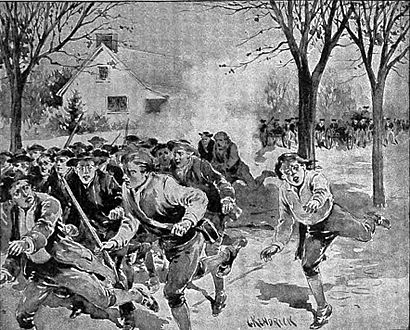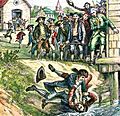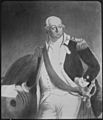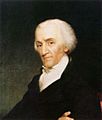Shays' Rebellion facts for kids
Quick facts for kids Shays' Rebellion |
|||
|---|---|---|---|

An artist's depiction of the rebellion: Shays' troops repulsed from the armory at Springfield, Massachusetts in early 1787
|
|||
| Date | August 29, 1786 – June 1787 | ||
| Location |
Western Massachusetts
|
||
| Caused by |
|
||
| Goals | Reform of state government, later its overthrow | ||
| Methods | Direct action to close courts, then military organization in attempt to capture the U.S. arsenal at the Springfield Armory | ||
| Resulted in | Rebellion crushed, and problems of Federal authority linked to the Articles of Confederation spur U.S. Constitutional Convention | ||
| Parties to the civil conflict | |||
|
|||
| Lead figures | |||
|
|||
| Number | |||
|
|||
| Casualties | |||
|
|||
Shays' Rebellion was a series of protests and a revolt by American farmers in Massachusetts. It happened between 1786 and 1787, mainly in the western part of the state, especially around Springfield. The rebellion is named after Daniel Shays, who was a soldier in the American Revolution. He became a leader of the farmers who were protesting.
These farmers were often called "Shaysites" or "Regulators." Most of them were poor and struggled to make a living. They were very upset about their debt (money they owed) and high taxes. Many farmers could not pay these taxes. They were afraid of being sent to jail or losing their farms and homes because of their debts.
The farmers tried to stop courts from taking property from people who owed money. They did this by forcing the courts in western Massachusetts to close. The people involved in Shays' Rebellion felt they were following the ideas of the American Revolution. They used symbols like "liberty poles" and "liberty trees" to show what they believed in.
Shays' Rebellion began on August 29, 1786. By January 1787, more than 1,000 Shaysites had been arrested. A special army, called a militia, was formed to stop the rebellion. On February 3, 1787, this militia stopped the main group of Shaysites from attacking the federal Springfield Armory, which was a place where weapons were stored.
The rebellion made many people worry that the new country was becoming too chaotic. It showed that the government under the Articles of Confederation was not strong enough. This worry helped lead to the creation of the United States Constitution.
Contents
Why Did the Rebellion Happen?
After the American Revolution, many farmers in Massachusetts faced hard times. The state government had high taxes to pay off its war debts. Farmers often had to pay these taxes in gold or silver, which was hard to get.
Economic Problems for Farmers
- Farmers had little money because trade was slow.
- They often borrowed money to buy land or tools.
- When they couldn't sell their crops, they couldn't pay back their loans or taxes.
- If they didn't pay, courts could take their land or send them to jail.
Government Actions
The government of Massachusetts, led by Governor James Bowdoin, was strict. They insisted on collecting taxes and debts. This made the farmers even more angry and desperate. They felt the government was not listening to their problems.
Who Was Daniel Shays?
Daniel Shays was a farmer and a soldier. He fought bravely in the American Revolution. He was at important battles like Bunker Hill and Saratoga. After the war, he returned to his farm in Massachusetts. Like many others, he faced financial trouble. He became a leader for the farmers who felt unfairly treated.
What Happened During the Rebellion?
The Shaysites started by protesting peacefully. They gathered in large groups to stop courts from meeting. This prevented judges from ordering farmers to lose their property.
Closing the Courts
- In the fall of 1786, groups of farmers, led by men like Job Shattuck and Luke Day, marched to courthouses.
- They forced the courts to close, stopping legal actions against debtors.
- They believed this was their right, just like colonists had protested British rule.
The Attack on Springfield Armory
The rebellion grew more serious. Daniel Shays planned to capture the Springfield Armory. This was a federal arsenal, meaning it held many weapons and gunpowder. If the rebels could get these weapons, they would be much stronger.
- On January 25, 1787, Shays led about 1,500 men towards the armory.
- General William Shepard and his Massachusetts militia defended the armory.
- Shepard's men fired cannons at the approaching rebels.
- The rebels were not prepared for this attack and quickly scattered.
- This defeat was a major blow to the rebellion.
The End of the Rebellion
After the failed attack on Springfield, General Benjamin Lincoln led a larger state militia. They chased the remaining rebels.
- On February 3, 1787, Lincoln's forces surprised Shays' men in Petersham.
- Many rebels were captured or fled.
- The rebellion effectively ended after this final battle.
What Was the Result of Shays' Rebellion?
The rebellion was put down, but it had a big impact on the young United States.
Impact on the Government
- It showed that the Articles of Confederation, the first plan for the U.S. government, was too weak.
- The national government could not easily raise an army or collect taxes to deal with such problems.
- This weakness worried many leaders, including George Washington.
Toward a New Constitution
The fear caused by Shays' Rebellion helped convince leaders that a stronger national government was needed. This led to the Constitutional Convention in 1787. At this meeting, a new plan for government, the United States Constitution, was written. The Constitution created a stronger federal government with the power to tax and maintain an army.
Aftermath for the Rebels
Many rebels were arrested. Some were sentenced to death, but most were later pardoned. Daniel Shays eventually received a pardon and lived out his life quietly.
Images for kids
-
Governor James Bowdoin instituted a heavy tax burden and stepped up a collection of back taxes.
-
General Benjamin Lincoln, portrait by Henry Sargent
-
This monument marks the spot of the final battle of Shays' Rebellion in Sheffield, Massachusetts.
-
Elbridge Gerry (1861 portrait by James Bogle) opposed the Constitution as drafted, although his reasons for doing so were not strongly influenced by the rebellion.
See also
 In Spanish: Rebelión de Shays para niños
In Spanish: Rebelión de Shays para niños








